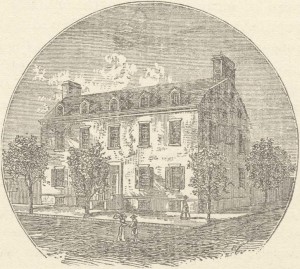
Our discussion of just where George Westinghouse went to school in Schenectady made us curious about the history of the Electric City’s early schools. Happily, George Rogers Howell was also curious and gave us some of the story in his “History of the County of Schenectady, from 1662 to 1886.” There were, as in all cities at the time, numerous independent teachers running what could loosely be called schools, but not organized and community supported institutions. The first attention to an organized school system in Schenectady dated back to the Revolution, but it was the coming of Dominie Dirck Romeyn as minister of the Dutch Reformed Church in 1784 that served as the inspiration of the Schenectady Academy in the following year. That Academy eventually grew into Union College, in a sense, and the early history of education in Schenectady saw the college and the academy tightly tied until the middle of the 19th century.
Through [Romeyn’s] influence the church was induced to erect a commodious building, the citizens agreeing to give it their patronage and furnish it with a library. The church contemplated constructing a house of two stories, with two rooms on each story, upon the lot of ground upon which the old guard-house now stands, at the junction of Church and State streets. Three rooms were to be assigned for the use of the school and academy. On account of the great cost of the Academy-house to the church, it was ‘resolved, that said church shall receive four shillings from every scholar taught in said house, and if said academy or Illustre School shall become changed into a college, then the presidents of such college, as well as the rector of said school, shall be a member of the Dutch Church and minister of this church; and the said four shillings for each scholar shall be bestowed upon such poor scholars as the church shall name.’
In 1785 it was determined to build the Academy instead at the north corner of Union and Ferry streets. A committee of citizens and the church consistory worked toward its completion; Howell writes that their names were cut into an oval stone which was, at the time of his writing, in the Union College Museum (and it would be great to know if the college still possesses it).
The Academy flourished from the start, enrolling 100 students within a year and continuing at that level for a decade, until Union’s founding in 1795. At that time, the College began conducting classes on the upper floor, and the grammar school continued on the lower floor. The growth and overcrowding led to the plans for a new building to be built on the edge of the city. The new West College was occupied in 1804, at the corner of Union and College streets. It may have been designed by Philip Hooker, who may have based it on the College of New Jersey’s (Princeton’s) Nassau Hall.
Howell was a bit of a plagiarist and not much of an editor, so his timelines could be confusing; he would lift materials from separate sources and not bother to integrate them. So it is with that warning that we repeat what Howell said, which he lifted from Pearson: in 1793, the Dutch Church “made the building over to the trustees of the academy; and on September 24, 1796, it was made over to the trustees of Union College, to be sold and the money put into a more commodious building. The proceeds of this sale were finally merged in the building fund of the present Union School edifice.”
The academy building was of brick, two stories in height, about 50 x 30 feet on the ground, and cost about $3,000. It was used by Union College until 1804. This school was opened in 1793 under the care of Col. John Taylor, of New Jersey. This school appears to have been conducted with much ability, and being well sustained by the community in which it was planted, became the germ of the college.
An academic school, in connection with Union College, was established by President Nott immediately after his election in 1804. The teachers of this school were appointed by him, and the principal was recognized by the laws of the college as a member of the faculty. This academic school became popular and extensively useful for many years.
On the 7th of April, 1818, an act was passed authorizing the revival and reorganization of the Schenectady Academy, which was done by the election of a Board of Trustees on the 1st day of April, 1819. The academic department of Union College was merged into this school . . . The academy continued until the reorganization of the schools of the city in 1854.

2 thoughts on “Schenectady’s first school”